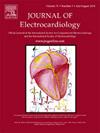The relationship between primary hyperparathyroidism and frontal QRS-T angle
IF 1.3
4区 医学
Q3 CARDIAC & CARDIOVASCULAR SYSTEMS
引用次数: 0
Abstract
Objective
Primary hyperparathyroidism (PHPT) is characterized by hypercalcemia due to elevated parathyroid hormone (PTH) levels. It has long been established that cardiac contraction and relaxation are primarily the result of recurrent phasic increases and decreases in cytoplasmic calcium ion concentration. Calcium balance plays a crucial role in ventricular repolarization and depolarization. This study aimed to investigate whether there is a relationship between the frontal QRS-T angle and newly diagnosed PHPT patients.
Methods
This study was designed as a prospective cross-sectional study. A total of 142 individuals were included, comprising 71 patients over the age of 18 who consented to participate and 71 healthy volunteers. Patients under the age of 18, those who declined to participate, and those with chronic kidney disease, heart failure, pericardial effusion, or undergoing oncological follow-up for malignancy were excluded from the study.
Results
In the patient group, the mean systolic blood pressure was 132 mm-Hg, and the mean diastolic blood pressure was 77.8 mm-Hg. These values were statistically significantly higher compared to the control group (p < 0.001). The mean frontal QRS-T angle on the ECG was −9.0° in the patient group and 2.0° in the control group. It was found that the frontal QRS-T angle in the patient group had wider angle values compared to the control group. This difference was considered statistically weakly significant (p < 0.001).
Conclusion
The frontal QRS-T angle in newly diagnosed PHPT patients differs from that in healthy individuals. We believe that the increase in this angle, calculated from the electrocardiogram obtained at the time of diagnosis, could serve as a warning parameter for clinicians in terms of the risk of cardiovascular complications.
原发性甲状旁腺功能亢进与额部QRS-T角的关系
目的原发性甲状旁腺功能亢进(PHPT)以甲状旁腺激素(PTH)水平升高引起的高钙血症为特征。长期以来,人们已经确定心脏收缩和舒张主要是细胞质钙离子浓度周期性升高和降低的结果。钙平衡在心室复极化和去极化中起着至关重要的作用。本研究旨在探讨额部QRS-T角度与新诊断的PHPT患者之间是否存在关系。方法本研究采用前瞻性横断面研究。共纳入142人,包括71名同意参与的18岁以上患者和71名健康志愿者。年龄在18岁以下的患者、拒绝参与的患者、患有慢性肾脏疾病、心力衰竭、心包积液或正在接受恶性肿瘤随访的患者被排除在研究之外。结果患者组平均收缩压为132 mm-Hg,平均舒张压为77.8 mm-Hg。与对照组相比,这些值有统计学意义上显著升高(p <;0.001)。患者组心电图QRS-T平均额位角为- 9.0°,对照组为2.0°。结果发现,与对照组相比,患者组QRS-T正面角值更宽。这种差异被认为在统计学上是弱显著的(p <;0.001)。结论初诊PHPT患者的QRS-T额位角与健康人不同。我们认为,从诊断时获得的心电图计算出的角度的增加可以作为临床医生心血管并发症风险的警告参数。
本文章由计算机程序翻译,如有差异,请以英文原文为准。
求助全文
约1分钟内获得全文
求助全文
来源期刊

Journal of electrocardiology
医学-心血管系统
CiteScore
2.70
自引率
7.70%
发文量
152
审稿时长
38 days
期刊介绍:
The Journal of Electrocardiology is devoted exclusively to clinical and experimental studies of the electrical activities of the heart. It seeks to contribute significantly to the accuracy of diagnosis and prognosis and the effective treatment, prevention, or delay of heart disease. Editorial contents include electrocardiography, vectorcardiography, arrhythmias, membrane action potential, cardiac pacing, monitoring defibrillation, instrumentation, drug effects, and computer applications.
 求助内容:
求助内容: 应助结果提醒方式:
应助结果提醒方式:


